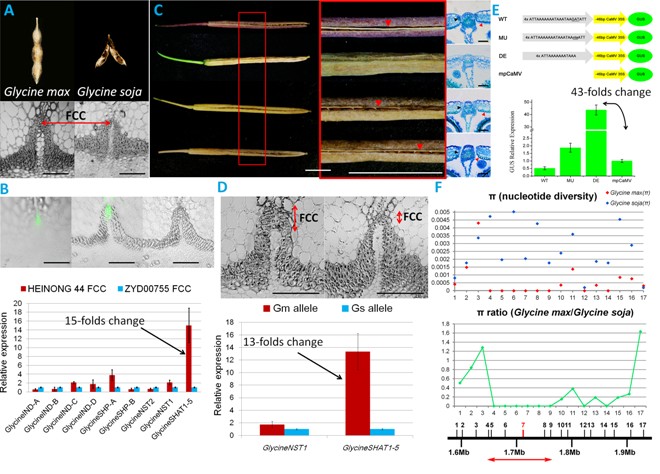A critical turning point in human history is the advent of Neolithic Revolution (ca. 10000 years ago) that resulted in a broad array of domesticated plant and animal species from their respective wild ancestors. The domesticated crops, which provide ancient people with food and energy, ignite the modern civilization. Loss of pod shattering, an agronomically important trait, which enables more efficient cultivation during crop domestication, was regarded as a milestone of soybean domestication. Scientists have continued to try to find the tissue contributing to pod shattering resistance and its underlying genetic mechanism in domesticated soybeans. However, the exact cellular and genetic mechanisms underlying this trait have yet to be determined.
Prof. WANG Yin-Zheng of the Institute of Botany, CAS and his colleagues employed multiple experimental approaches to explore the genetic mechanism underlying the evolution of shattering-resistant phenotype in domesticated soybeans. They show that the key cellular feature of the shattering-resistant trait lies in the excessively lignified fiber cap cells (FCC) with the abscission layer unchanged in the pod ventral suture. They demonstrate that a NAC (NAM, ATAF1/2 and CUC2) gene, SHATTERING1-5 (SHAT1-5) functionally activates secondary wall biosynthesis and promotes the significant thickening of FCC secondary walls by expression at 15-fold the level of the wild allele, which is attributed to functional disruption of the upstream repressor. They also show that strong artificial selection of SHAT1-5 has caused a severe selective sweep across ~116kb on chromosome 16.
During crop domestication, loss of seed dispersal or fruit shattering has been known to be associated with abscission layer disruptions consequent upon related gene function alterations. In domesticated soybeans, the key domesticated cellular feature responsible for the shattering resistance lies in the fiber cap cells (FCC), rather than the abscission layer, in the ventral suture of the pod. This is a novel mechanism which is distinct from the one underlying grain shattering resistance of domesticated cereals and could be applicable to legume crop improvement.
The above research has just been published online in Nature Communications on Feb. 19th, 2014. For more information about this work, please contact Prof. WANG Yin-Zheng at wangyz@ibcas.ac.cn

The evolutionary mechanism of pod shattering resistance in domesticated soybeans
(A) Comparative anatomic analysis of pod shattering character in domesticated soybean and wild soybean; (B) Expression analysis of SHAT1-5 gene in the FCC; (C) Functional investigation of SHAT1-5 coding sequence in Arabidopsis nst1-1;nst3-1mutant; (D) Functional analysis of SHAT1-5 in F2 plants derived from crossing between domesticated soybean and wild soybean; (E) Functional analysis of GARP cis-regulatory element; (F) Detection of an artificial related selection in SHAT1-5 locus.
A critical turning point in human history is the advent of Neolithic Revolution (ca. 10000 years ago) that resulted in a broad array of domesticated plant and animal species from their respective wild ancestors. The domesticated crops, which provide ancient people with food and energy, ignite the modern civilization. Loss of pod shattering, an agronomically important trait, which enables more efficient cultivation during crop domestication, was regarded as a milestone of soybean domestication. Scientists have continued to try to find the tissue contributing to pod shattering resistance and its underlying genetic mechanism in domesticated soybeans. However, the exact cellular and genetic mechanisms underlying this trait have yet to be determined.
Prof. WANG Yin-Zheng of the Institute of Botany, CAS and his colleagues employed multiple experimental approaches to explore the genetic mechanism underlying the evolution of shattering-resistant phenotype in domesticated soybeans. They show that the key cellular feature of the shattering-resistant trait lies in the excessively lignified fiber cap cells (FCC) with the abscission layer unchanged in the pod ventral suture. They demonstrate that a NAC (NAM, ATAF1/2 and CUC2) gene, SHATTERING1-5 (SHAT1-5) functionally activates secondary wall biosynthesis and promotes the significant thickening of FCC secondary walls by expression at 15-fold the level of the wild allele, which is attributed to functional disruption of the upstream repressor. They also show that strong artificial selection of SHAT1-5 has caused a severe selective sweep across ~116kb on chromosome 16.
During crop domestication, loss of seed dispersal or fruit shattering has been known to be associated with abscission layer disruptions consequent upon related gene function alterations. In domesticated soybeans, the key domesticated cellular feature responsible for the shattering resistance lies in the fiber cap cells (FCC), rather than the abscission layer, in the ventral suture of the pod. This is a novel mechanism which is distinct from the one underlying grain shattering resistance of domesticated cereals and could be applicable to legume crop improvement.
The above research has just been published online in Nature Communications on Feb. 19th, 2014. For more information about this work, please contact Prof. WANG Yin-Zheng at wangyz@ibcas.ac.cn

The evolutionary mechanism of pod shattering resistance in domesticated soybeans
(A) Comparative anatomic analysis of pod shattering character in domesticated soybean and wild soybean; (B) Expression analysis of SHAT1-5 gene in the FCC; (C) Functional investigation of SHAT1-5 coding sequence in Arabidopsis nst1-1;nst3-1mutant; (D) Functional analysis of SHAT1-5 in F2 plants derived from crossing between domesticated soybean and wild soybean; (E) Functional analysis of GARP cis-regulatory element; (F) Detection of an artificial related selection in SHAT1-5 locus.
